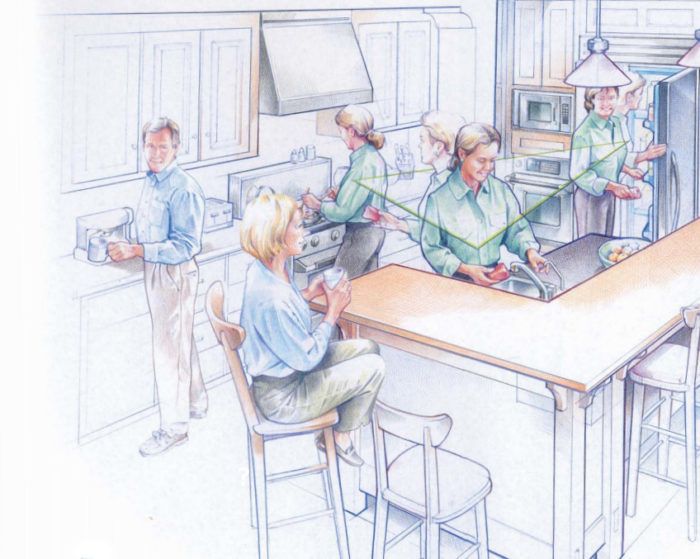The New Kitchen Triangle
Improve work flow to accommodate more appliances, more cooks, and more activities.

Synopsis: The “work triangle,” consisting of sink, stove, and refrigerator, has long been a basic of good kitchen design. But the introduction of new appliances, along with changes in the way we work in the kitchen, can make applying the traditional triangle concept a challenge. In this article, certified master kitchen and bath designer Ann Morris helps readers understand how to apply this design basic in today’s multi-functional (and often, multi-cook) kitchen.
The “work triangle” has been a part of good kitchen design for nearly 50 years. The idea is to arrange your refrigerator, sink, and stove in a triangle, with no leg of the triangle longer than 9 feet or shorter than 4 feet. This makes for efficient movement as you gather food from the fridge, prepare it at the sink, and cook it at the stove.
But kitchens have changed over the decades. They’re bigger, they hold more appliances, and they’re often at the center of family activities. The challenge is to make sure they’re still good places to cook, which is, after all, what the triangle is designed to do. But where does a second sink fit in to the traditional triangle? Where’s the cooking corner when your oven is in the wall and your stovetop is adrift on an island? And where should the espresso machine go?
The work triangle is still an effective way to think about kitchen layout. But it is important first to figure out the role each of your kitchen’s features plays in the cooking sequence— if it plays a role at all—to determine whether it fits in the triangle or is better left outside.
Inside the basic triangle
The traditional work triangle is built around “centers” anchored by the three major appliances. The sink center is the site of food prep and cleanup, the refrigerator center functions as a place for food storage, and the cooking center is, of course, where you heat, sauté, grill, and fry. Thinking of each center as a place with a specific function rather than simply an appliance makes it easier to adapt the concept to today’s kitchen. These days, even the most basic kitchens consist of more than a sink, stove, and refrigerator. Most of us have a microwave and a dishwasher and recycling to be collected. When you keep function in mind, these and other add-ons can usually fit easily into the traditional triangle’s centers.
Separate cooking appliances, where the cooktop is in one place and the oven (or ovens) somewhere else, can confuse the triangle concept, which is based on the idea that a kitchen’s cooking area consists of a single, unified range. But generally, the cooktop— because it is used more often and more actively than the oven— is considered the primary cooking center and is the appliance included in the basic triangle. The oven, then, is free to be placed anywhere. One good solution is to place it so that it forms its own triangle with the sink and the refrigerator. Or, for aesthetic and practical reasons, you might stack ovens near the refrigerator, keeping “tall” features together. A warming drawer can be placed in either the cooking center or outside the general triangle, where it would be convenient for serving.
For more photos and detail on creating a multi-functional kitchen, click the View PDF button below.

























